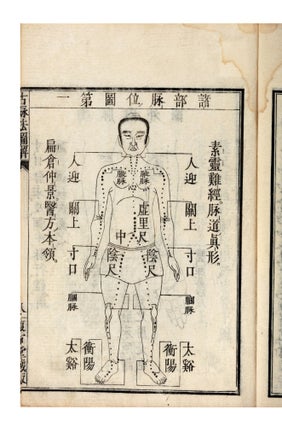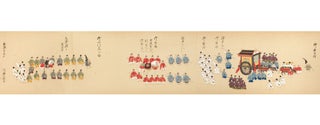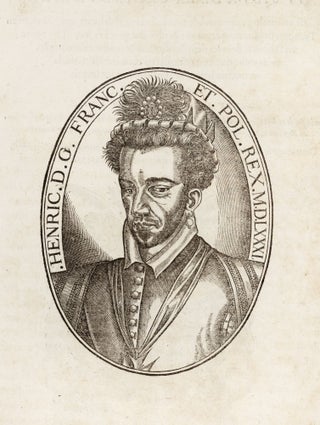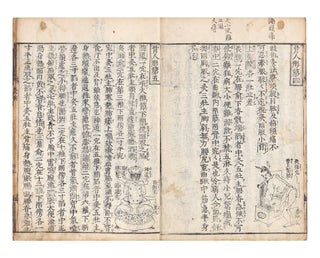Printed in Chinese, Siddham, & Han’gŭl;
Printed at a Nunnery
AMITABHASUTRA (in Sanskrit); [Ch.: Fo shuo amituo jing yao jie; K.: Pulsol amit’a kyong yohae 佛說阿彌陀經要解; The Smaller Sukhavativyuha Sutra [or] The Amitabhasutra]
Trans. by Kumarajiva. Commentary by Ouyi Zhixu. Four splendid full-page woodcuts. 54 folding leaves. Large 8vo (318 x 198 mm.), orig. yellow-brown patterned wrappers, new stitching. Naewon’am, “The Inner Courtyard Nunnery,” Samgaksan: 1853.
A rare reprint of the 1753 edition of The Smaller Sukhavativyuha Sutra, one of the three most important Mahayana sutras of the Pure Land tradition, printed in 1853 (Xianfeng 3), at Naewon’am 內院庵, “The Inner Courtyard Nunnery” at Samgaksan 三角山, a peak of Pukhansan mountain north of Seoul.
The printing of our edition was financed by donations from nuns and lay believers. The names of donors are printed in the margins of some folios. Our edition contains the influential commentary by Ouyi Zhixu (or Chih-hsu, 1599-1655), one of the four eminent monks of the late-Ming dynasty. His Pure Land writings have been especially influential and are regarded as integral to the modern Chinese Pure Land tradition. He was “an eminent monk and revitalizer of Pure Land Buddhism in Ming-dynasty China…he is remembered as one of the great revivers of Buddhism in the mid to late Ming period.”–Keown, A Dictionary of Buddhism, p. 56.
The first page of this edition opens with the names and titles of two individuals, one man and one woman. On the basis of the surname, official title, birth year (chŏngsa), the first individual can be identified as Kim Chwa-kŭn (1797-1869), a high-ranking official. The second individual is a woman (konmyŏng) née Yang, born in 1816 (pyŏngja), who was probably Kim’s wife. They were donors towards the printing of this book (the text talks about their “gift” [hye]).
Their names are followed by an undated preface, signed by the sobriquet Chang’wan of Kŭmsan Mountain Hall (Kŭmgye Tang Chang’wan). This mountain is located in South Ch’ungch’ŏng province of present-day South Korea. The preface explains the purpose of Amitâbhasutra as helping people find release from the sea of bitterness and seek the Pure Land. The preface also explains the background of the re-printing of the book. Chang’wan says that it was printed at the beginning of summer of the kyech’uk year. This refers to 1853, which is the only kyech’uk year in Kim Hŭng-kyŏng’s lifetime.
Kumarajiva (344-409/413), Buddhist monk, scholar, missionary, and translator, came from the Silk Road kingdom of Kucha. Famous for his encyclopedic knowledge of Indian and Vendantic learning, he was the greatest translator of Buddhist scripture from Sanskrit into Chinese, and it was largely owing to his efforts and influence that Buddhist religious and philosophical ideas were disseminated in China. Following many years of study in Kucha and Kashmir, he arrived in Chang’an (now Xi’an), in 401 with a great reputation. He became known as “teacher of the nation.” There, he headed a famous school of translators, and together they translated many important Buddhist texts into Chinese.
The book is illustrated with four splendid full-page woodcuts, including one the commentator Ouyi Zhixu, shown at his desk with a young disciple standing next to him, holding two scrolls.
The final two leaves contains mantras written in the Indic Siddham script and in a version of the Korean alphabet (han’gŭl) that has been modified through the addition of diacritics to better represent the foreign sounds.
The copy at Berkeley (from the Asami library, see below) is incorrectly described in WorldCat as the 1753 edition (accession no. 747738905). It is, in fact, the 1853 edition.
“[C]ommentaries on the Sukhavativyuha, one of the basic books of the Pure Land Sect. The text is the Chinese translation by Kumarajiva, and the commentaries were made in 1647 by Chih-hsu (1599-1655), a patriarch of the T’ien-t’ai Sect. Our copy is from the 1853 Seoul edition, which was a reprint of the 1753 Wu Shang-hsien edition. The reprint includes two leaves of [four] illustrations and a dedicatory leaf to the sponsors, Premier [Prime Minister] Kim Chwa-gun (1797-1869) and his wife, who ordered a thousand copies, ‘praying to get an unusual son.’ The names of the other sponsors, as in most Korean editions of Buddhist works, are found on the inside margins. At the end of this edition are added two leaves of chants in Sanskrit” (Fang, The Asami Library, 28.19, pp. 234-35)
A fine copy. Minor marginal worming to first and final leaves.
References
Fang Chaoying. The Asami Library: A Descriptive Catalog. Edited by Elizabeth Huff. Berkeley: University of California Press, 1969.
Price: $9,500.00
Item ID: 7022

![Item ID: 7022 AMITABHASUTRA (in Sanskrit); [Ch.: Fo shuo amituo jing yao jie; K.: Pulsol amit’a kyong yohae 佛說阿彌陀經要解; The Smaller Sukhavativyuha Sutra [or] The Amitabhasutra]](https://jonathanahill.cdn.bibliopolis.com/pictures/7022.jpg?width=768&height=1000&fit=bounds&auto=webp&v=1589415876)
![AMITABHASUTRA (in Sanskrit); [Ch.: Fo shuo amituo jing yao jie; K.: Pulsol amit’a kyong yohae 佛說阿彌陀經要解; The Smaller Sukhavativyuha Sutra [or] The Amitabhasutra]](https://jonathanahill.cdn.bibliopolis.com/pictures/7022_2.jpg?width=320&height=427&fit=bounds&auto=webp&v=1589415876)
![AMITABHASUTRA (in Sanskrit); [Ch.: Fo shuo amituo jing yao jie; K.: Pulsol amit’a kyong yohae 佛說阿彌陀經要解; The Smaller Sukhavativyuha Sutra [or] The Amitabhasutra]](https://jonathanahill.cdn.bibliopolis.com/pictures/7022_3.jpg?width=320&height=427&fit=bounds&auto=webp&v=1589415876)



